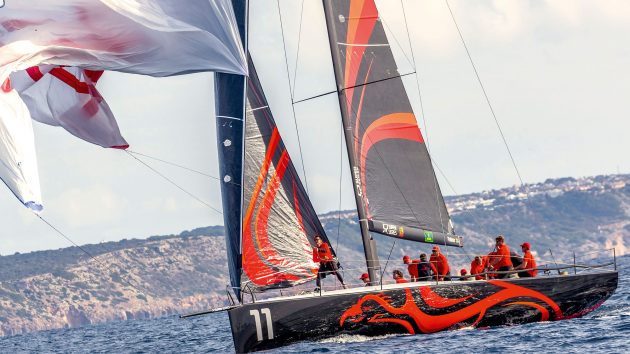Hamble-based Dave Swete is one of the most in-demand professional sailors in the UK. He tells Andy Rice his five top tips for a safe and rapid spinnaker ‘string drop’ using modern takedown systems.
Dinghies like the 505 have been using chutes to ‘string drop’ their spinnakers into the boat for decades. However, when specifically talking about the big boat spinnaker drop, the string drop wasn’t seen until the latter days of the Version 5 IACC yachts, which last contested the America’s Cup in Valencia 2007.
Many of those same America’s Cup sailors and sailmakers continued to develop string drop techniques for grand prix racing classes like the TP52 and Maxi 72, and we increasingly see other, smaller boats adopting the technique.
Dave Swete estimates he does about 500 string drops a year and reckons it’s worth a lot of time around the race track, saving up to 30 seconds per leeward mark rounding. In light to medium airs, the very best string drop manoeuvres don’t even begin until the boat is nearly ready to head up around the mark.
For port roundings at top marks, a general rule is for the dropline to be on the port side of a gennaker for an ‘inside gybing’ boat and on the starboard side of a gennaker for an ‘outside gybing’ boat. The dropline should be led down the port side with enough ‘tail’ for it to allow for gybing.
Choreography
To execute a good string drop, a lot of things need to happen quickly, and in the correct order.
Around one minute out from the mark the jib should be going up and the crew should be thinking about getting the boat ready for upwind sailing. Someone not involved in the physical side of the manoeuvre should be watching the mark and giving a clear countdown so everyone knows when to execute their role.
It’s critical the helmsman levels the boat and keeps the mast upright for the duration of the drop: this massively reduces the risk of the sail catching in the water.
A clear loud final call: ‘10 seconds to drop!’ is imperative, with sheets, halyards, tacklines all being released in the correct order in the final two seconds.
Windward drop
Provided the boat is level and the steps take place at the correct times, this is a very safe manoeuvre.
Bear away until the boat is flat (the jib starting to come to windward is a good indication you’re at the right angle for a drop), release the sheet and tackline simultaneously while pulling the dropline on the ‘two seconds’ call and the kite will go up in the air, just floating.
It’s a bizarre sight watching the kite floating above you, with the real wind balanced out by the apparent wind across the deck meaning the sail just hangs there, ready to be sucked down the hatch.
Wait until the dropline just starts going tight and then release the halyard (normally on the ‘zero seconds’ call). There should be very little resistance to get the kite away very quickly, and gravity will give you a helping hand.

ROBERTISSIMA III. ©Rolex/Carlo Borlenghi
Leeward drop
Timing is much more critical on the leeward drop as there’s a higher chance of the kite falling overboard to leeward. This is why it’s vital the helmsman keeps the boat upright and steers the boat dead downwind, again watch for when the jib starts to want to cross the boat as a good indication that you’re deep enough.
It’s also really important to release ropes in the right order. At the same time as the trimmer releases the sheet, the pitman releases the halyard and the kite is pulled in to leeward by the dropline. The tackline must be released last of all and only once the majority of the sail is safely down the hatch, because if any of the sail drops in the water and you’ve released the tackline too early, you’ll have to deal with a full-on boat-stopping trawl.
Max horsepower
On boats up to about 40ft long, you can put your biggest, strongest sailor on the dropline and they should be able to manually haul the string line in by themselves. On boats 40ft and upwards you’d usually have the dropline on a wheel linked through a pedestal and have strong grinders getting the sail below decks ASAP.
Boat conversion
Raceboats tend to prefer a single-patch system attached to the centre of the kite. But then raceboats are stripped out with minimal interiors and furniture, which enables a full run of the interior to get the kite down below.
If you’re keen to do string drops on a less race-oriented boat, but there’s a bulkhead or something getting in the way, you can look at running a two-patch system on your kite, which will shorten the distance that the sail needs to be pulled below, before it becomes ‘safe’.
Check that the sail will run smoothly and freely down the forehatch with no chance of snagging on a sharp edge. The ideal set-up is to have a roller bar or smooth radius on the aft end of the hatch for the sail to roll around. The smaller the boat and the lower the loads, the easier it should be to execute a string drop. The manoeuvre works nicely on all race boats up to the Maxi 72s – beyond that, the size and the loads become a limiting factor.
 If you enjoyed this….
If you enjoyed this….
Yachting World is the world’s leading magazine for bluewater cruisers and offshore sailors. Every month we have inspirational adventures and practical features to help you realise your sailing dreams.Build your knowledge with a subscription delivered to your door. See our latest offers and save at least 30% off the cover price.





